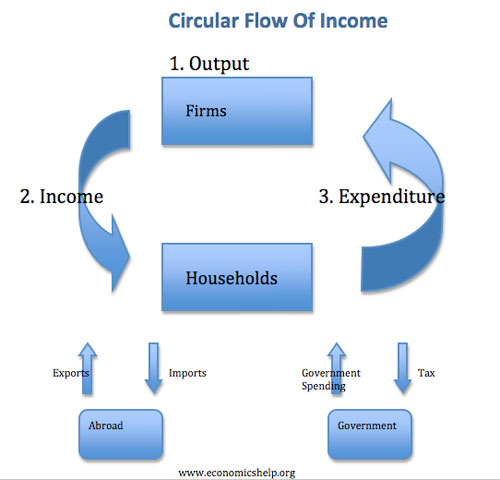Circular Flow of Income Diagram
The Circular flow of income diagram models what happens in a very basic economy.


In the very.basic model, we have two principal components of the economy:
- Firms. Companies who pay wages to workers and produce output.
- Households. Individuals who consume goods and receive wages from firms.
This circular flow of income also shows the three different ways that National Income is calculated.
- National Output. Output produced by firms.
- National Income. The total income received by people in the economy. For example, firms have to pay workers to produce the output. Therefore income flows from firms to households.
- National Expenditure. Total amount spent on goods and services. For example, with wages from work, households can then buy goods produced by firms. Therefore, the spending goes back to firms.
This represents a simple economic model; it is a closed economy without any government intervention.
In the real world it is more complicated. We also add two more components:
- Government. The government taxes firms and consumers, and then spends money, e.g. health care and education.
- Foreign sector. We sell exports abroad and buy imports. Therefore, there is a flow of money between one country and the rest of the world.
Withdrawals (W) into Circular Flow of Income
Withdrawals are items that take money out of the circular flow. This includes:
- Savings (S) (money not used to finance consumption, e.g. saved in a bank)
- Imports (M) (money sent abroad to buy foreign goods)
- Taxes (T) (money collected by government, e.g. income tax and VAT)
Injections (J) into Circular Flow of Income
Spending that puts money into the circular flow of income.
- Investment (I). Money invested by firms into purchasing capital stock.
- Exports (X). Money coming from abroad to buy domestically produced goods.
- Government spending (G). Government welfare benefits, spending on infrastructure.
- Circular flow of income
- Intrepix: http://intrepix.tripod.com/ Dec 2002
- Copyright © Enoch Lau 2002
- ····································································································
- Page 1 of 2
- The Circular Flow of Income
- The five-sector circular flow model describes the operation of the economy and the linkages
- between the main sectors in the economy. The five-sector model is based on dividing the
- economy into five sectors. A sector may be defined as a part of the economy where the
- participants are engaged in a similar type of economy activity.
- 1. Individuals
- 2. Businesses
- 3. Financial institutions
- 4. Government
- 5. International Trade
- Individuals
- ƒ This sector consists of all individuals in the economy.
- ƒ These individuals are the owners of productive resources, and the consumers in our
- economy.
- ƒ Individuals supply factors of production (inputs) such as labour and enterprise to
- businesses, which they use to produce goods and services. As a reward for supply
- resources such as labour and enterprise to firms, individuals receive incomes – rent,
- wages, interest and profit.
- Businesses
- ƒ This sector consists of all the business firms engaged in the production and
- distribution of goods and services (apart from financial services).
- ƒ It concerns all their activities involved with buying factors of production and using
- them to produce and sell goods and services.
- ƒ Individuals and businesses are interdependent.
- Financial Institutions ƒ This sector consists of all those institutions that are engaged in the borrowing and
- lending of money, acting as the intermediaries between those who save, and
- borrowers of money.
- ƒ Financial institutions are needed for individuals and firms to be able to undertake
- saving and investment. They perform the function of mobilising savings for
- investment.
- ƒ Savings: leakage; Investment: injection
- Individuals Businesses
- Financial Institutions
- Government
- International Flows
- Income rewards
- Expenditure on goods and services
- Savings Investment
- Taxation Expenditure
- Imports ExportsCircular flow of income
- Intrepix: http://intrepix.tripod.com/ Dec 2002
- Copyright © Enoch Lau 2002
- ····································································································
- Page 2 of 2
- Government
- ƒ In Australia, this sector consists of the Commonwealth, State and local governments.
- ƒ It is involved in the satisfaction of collection (community) wants.
- ƒ It obtains the resources to do this through imposing taxes on the other sectors of the
- economy.
- ƒ It uses this tax revenue to undertake various government expenditures.

No comments:
Post a Comment